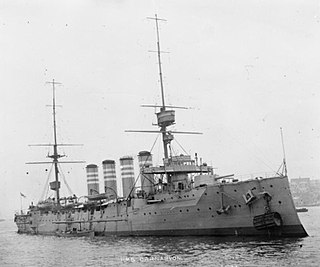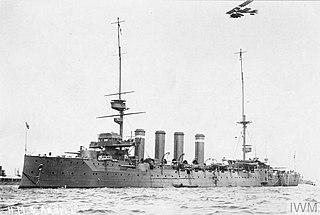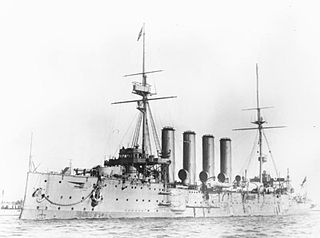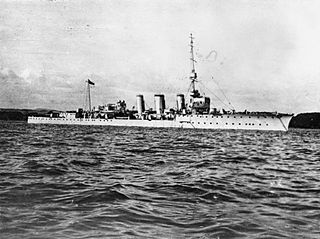Design and description
Antrim was designed to displace 10,850 long tons (11,020 t). The ship had an overall length of 473 feet 6 inches (144.3 m), a beam of 68 feet 6 inches (20.9 m) and a deep draught of 24 feet (7.3 m). She was powered by two 4-cylinder triple-expansion steam engines, each driving one shaft, which produced a total of 21,000 indicated horsepower (16,000 kW) and gave a maximum speed of 22 knots (41 km/h; 25 mph). The engines were powered by seventeen Yarrow and six cylindrical boilers. [1] She carried a maximum of 1,033 long tons (1,050 t) of coal and her complement consisted of 610 officers and ratings. [2]
Her main armament consisted of four breech-loading (BL) BL 7.5-inch Mk I guns mounted in four single-gun turrets, one each fore and aft of the superstructure and one on each side. [3] The guns fired their 200-pound (91 kg) shells to a range of about 13,800 yards (12,600 m). [4] Her secondary armament of six BL 6-inch Mk VII guns was arranged in casemates amidships. Four of these were mounted on the main deck and were only usable in calm weather. [5] They had a maximum range of approximately 12,200 yards (11,200 m) with their 100-pound (45 kg) shells. [6] Antrim also carried 18 quick-firing (QF) 3-pounder Hotchkiss guns and two submerged 18-inch torpedo tubes. [1] Her two 12-pounder 8 cwt guns could be dismounted for service ashore. [3]
At some point in the war, the main deck six-inch guns of the Devonshire-class ships were moved to the upper deck and given gun shields. Their casemates were plated over to improve seakeeping and the four 3-pounder guns displaced by the transfer were landed. [7]
The ship's waterline armour belt had a maximum thickness of six inches (152 mm) and was closed off by five-inch (127 mm) transverse bulkheads. The armour of the gun turrets was also five inches thick whilst that of their barbettes was six inches thick. The protective deck armour ranged in thickness from .75–2 inches (19–51 mm) and the conning tower was protected by twelve inches (305 mm) of armour. [1]
Construction and service
Antrim, named to commemorate the Irish county, [8] was laid down by John Brown & Company at their Clydeside shipyard on 27 August 1902 and launched on 8 October 1903. She was completed on 23 June 1905 [1] and was initially assigned to the 1st Cruiser Squadron of the Channel Fleet together with most of her sister ships. She was sent to Casablanca, Morocco August 1907 following an insurrection that led to the bombardment of Casablanca. [9] She was transferred to the 2nd Cruiser Squadron of the Atlantic Fleet in March 1907 and was then assigned to the reserve Third Fleet at Devonport in April 1909. She was moved to the Mersey during the 1911 Liverpool general transport strike. [10] In December 1912 the ship became the flagship of the 3rd Cruiser Squadron of the Second Fleet. [11]
The squadron was assigned to the Grand Fleet in mid-1914 as the Navy mobilised for war. It spent much of its time with the Grand Fleet reinforcing the patrols near the Shetland and Faeroe Islands and the Norwegian coast [12] where Antrim captured a German merchantman on 6 August. [11] Two months later, she was unsuccessfully attacked by the German submarine U-16 on 9 October. [13] Despite numerous sorties with the main body of the Grand Fleet, she did not see combat. The ship was sent to Archangelsk in June 1916 and was then transferred for convoy escort duties to the North America and West Indies Station. Antrim returned home in December 1917 and was paid off. She was recommissioned in August 1918 and resumed her former duties until the end of the war in November. [11]
She was in reserve at the Nore in 1919, but was modified to conduct radio and Asdic trials. She recommissioned in March 1920 for the trials and became a cadet training ship in 1922. [11] Antrim was sold for scrap on 19 December 1922 and was subsequently broken up at Blyth, Northumberland. [8]

HMS Carnarvon was one of six Devonshire-class armoured cruisers built for the Royal Navy in the first decade of the 20th century. She was assigned to the 3rd Cruiser Squadron of the Mediterranean Fleet upon completion in 1905 and was transferred to the 2nd Cruiser Squadron of the Atlantic Fleet in 1907. She was assigned to the reserve Third Fleet in 1909 and became flagship of the 5th Cruiser Squadron of the reserve Second Fleet in 1912.

HMS Cornwall was one of 10 Monmouth-class armoured cruisers built for the Royal Navy in the first decade of the 20th century. She was assigned to the 2nd Cruiser Squadron of the Channel Fleet on completion in 1903. The ship was refitted in 1907 in preparation for service as a training ship for cadets with the 4th Cruiser Squadron on the North America and West Indies Station beginning in 1908.

HMS Argyll was one of six Devonshire-class armoured cruisers built for the Royal Navy in the first decade of the 20th century. She was assigned to the 1st Cruiser Squadron of the Channel Fleet upon completion and was transferred to the 5th Cruiser Squadron of the Atlantic Fleet in 1909. Two years later, she was detached to escort the royal yacht during King George V's trip to British India. Argyll was assigned to the 3rd Cruiser Squadron of the reserve Second Fleet in 1913.

HMS Bacchante was a Cressy-class armoured cruiser built for the Royal Navy around 1900. Upon completion she was assigned to the Mediterranean Fleet as flagship of the fleet's cruiser squadron. She was reduced to reserve upon her return home in 1905 before returning to the Mediterranean in 1906. Six years later she returned home and was again placed in reserve. Recommissioned at the start of World War I, Bacchante became flagship of the 7th Cruiser Squadron. She was present at the Battle of Heligoland Bight a few weeks after the war began, but saw no combat.

The Minotaur class was a three-ship class of armoured cruisers built in the first decade of the twentieth century for the Royal Navy. These were the last class of armoured cruisers built for the Royal Navy, with that role being substantially replaced by the first battlecruisers. These initially served with the Home Fleet, generally as the flagships of cruiser squadrons. Minotaur became flagship of the China Station in 1910 and Defence served as flagship of the 1st Cruiser Squadron in the Mediterranean from 1912; Shannon remained at home as flagship of several different squadrons.

HMS Hyacinth was one of three Highflyer-class protected cruisers built for the Royal Navy in the 1890s. Initially assigned to the Channel Fleet, she spent much of her early career as flagship for the East Indies Station. She was reduced to reserve in 1912 after a lengthy refit before becoming the flagship of the Cape of Good Hope Station in 1913. After the beginning of World War I in August 1914, she spent the first few months of the war escorting convoys around South Africa. In early 1915, she was deployed to German East Africa to blockade the German light cruiser SMS Königsberg. She destroyed a German blockade runner attempting to bring supplies through the blockade in April and sank a German merchant vessel in early 1916. Hyacinth remained on the Cape Station for the rest of the war and was paid off in 1919, although she was not sold for scrap until 1923.

HMS Hogue was a Cressy-class armoured cruiser built for the Royal Navy around 1900. Upon completion she was assigned to the Channel Fleet and the China Station. In 1906 she became a training ship for the North America and West Indies Station before being placed in reserve in 1908. Recommissioned at the start of World War I, she played a minor role in the Battle of Heligoland Bight a few weeks after the beginning of the war. Hogue was sunk by the German submarine U-9, together with two of her sister ships, on 22 September 1914.

HMS Sutlej was a Cressy-class armoured cruiser built for the Royal Navy around 1900. Upon completion she was assigned to the China Station. In 1906 she became a training ship for the North America and West Indies Station before returning home and being assigned as the flagship of the reserve Third Fleet in 1909. Relieved as flagship in 1910, she remained in reserve until the beginning of World War I in August 1914.

HMS Euryalus was a Cressy-class armoured cruiser built for the Royal Navy around 1900. Badly damaged by multiple accidents while fitting out, she was not completed until 1904. She became flagship of the Australia Station that year and was reduced to reserve upon her return in 1905. Recommissioned in 1906, she became a training ship for the North America and West Indies Station before being placed in reserve with the Third Fleet in 1909.

HMS King Alfred was one of four Drake-class armoured cruisers built for the Royal Navy around 1900. She served as flagship of the China Station from 1906 until relieved in 1910. Upon her return home that year, she was placed in reserve before being recommissioned in mid-1914. She was assigned to the 6th Cruiser Squadron of the Grand Fleet at the beginning of World War I. She was transferred to the 9th Cruiser Squadron in 1915 and assigned to convoy protection duties by the end of the year. King Alfred participated in the unsuccessful searches for the German commerce raider SMS Möwe in 1916–17 before beginning to escort convoys later that year. The ship was torpedoed by a German submarine in 1918, but returned to service. She was sold for scrap in 1920.

HMS Leviathan was one of four Drake-class armoured cruisers built for the Royal Navy around 1900. She was assigned to the China Station upon completion and then served in the Mediterranean Fleet in 1905–06. She was assigned to the 7th Cruiser Squadron in 1907 before she was briefly reduced to reserve. Leviathan was recommissioned in 1909 for service with the 4th Cruiser Squadron before she was placed in reserve in 1913.

HMS Essex was one of 10 Monmouth-class armoured cruisers built for the Royal Navy in the first decade of the 20th century. Upon completion in 1904 she was assigned to the 2nd Cruiser Squadron of the Channel Fleet. The ship was placed in reserve in March 1906 and recommissioned in 1909 for service with the 4th Cruiser Squadron on the North America and West Indies Station. In 1912, Essex returned home and was assigned to the Training Squadron of the Home Fleet. After a refit the following year, she rejoined the 4th Cruiser Squadron in early 1914.

HMS Berwick was one of 10 Monmouth-class armoured cruisers built for the Royal Navy in the first decade of the 20th century. She was assigned to the 2nd Cruiser Squadron of the Channel Fleet upon completion in 1903 and was transferred to the Home Fleet in 1906. She accidentally rammed and sank a British destroyer in 1908. Berwick was refitted in 1908–09 before she was transferred to the 4th Cruiser Squadron on the North America and West Indies Station later that year.

HMS Cumberland was one of 10 Monmouth-class armoured cruisers built for the Royal Navy in the first decade of the 20th century. She was assigned to the 2nd Cruiser Squadron of the Channel Fleet upon completion in 1903. After a refit in 1907–1908 she became a training ship in the Home Fleet. She was sent to West Africa after the beginning of World War I in August 1914 and captured 10 German merchant ships in September. Cumberland spent the rest of the war on convoy escort duties and patrolling for German commerce raiders. She was sold for scrap in 1921 and broken up two years later.

HMS Donegal was one of 10 Monmouth-class armoured cruisers built for the Royal Navy in the first decade of the 20th century. She was initially assigned to the 1st Cruiser Squadron upon completion in 1903 and ran aground en route to the China Station in 1906. She was briefly placed in reserve after repairs before she was assigned to the Home Fleet in 1907. She joined the 4th Cruiser Squadron on the North America and West Indies Station in 1909 before returning home for an assignment with the Training Squadron in 1912. Donegal was reduced to reserve before World War I began in August 1914 as part of the Third Fleet

HMS Lancaster was one of 10 Monmouth-class armoured cruisers built for the Royal Navy in the first decade of the 20th century. Upon completion she was assigned to the 3rd Cruiser Squadron of the Mediterranean Fleet. She remained there until 1912 when she returned home to be placed in reserve. The ship was recommissioned in 1913 for service with the 4th Cruiser Squadron on the North America and West Indies Station. She remained there until she was assigned to the Grand Fleet in 1915. She was transferred to the Pacific in 1916 and she became flagship of the Eastern Squadron in 1918. The ship was sold for scrap in 1920.

HMS Devonshire was the lead ship of her class of six armoured cruiser built for the Royal Navy in the first decade of the 20th century. She was assigned to the 1st Cruiser Squadron of the Channel Fleet upon completion in 1905 and was transferred to the 2nd Cruiser Squadron of the Atlantic Fleet in 1907. She was assigned to the reserve Third Fleet in 1909 and then to the 3rd Cruiser Squadron of the reserve Second Fleet in 1913.

HMS Roxburgh was one of six Devonshire-class armoured cruisers built for the Royal Navy in the first decade of the 20th century. She was assigned to the 1st Cruiser Squadron of the Channel Fleet upon completion and was transferred to the reserve Third Fleet in 1909. She was then assigned to the 5th Cruiser Squadron of the reserve Second Fleet in 1912 and the 3rd Cruiser Squadron the following year.

HMS Minotaur was the lead ship of the Minotaur-class armoured cruisers built for the Royal Navy. Launched in 1906, she served as the flagship of the China Station before the First World War. Shortly after the war began, the ship searched unsuccessfully for the German East Asia Squadron and was transferred to the Grand Fleet at the end of 1914. During the rest of the war Minotaur served as the flagship of the 7th and 2nd Cruiser Squadrons and spent most of her time assigned to the Northern Patrol. In mid-1916 she participated in the Battle of Jutland but did not fire her weapons during the battle. The ship was paid off in 1919 and sold for scrap the following year.

HMS Cordelia was a C-class light cruiser built for the Royal Navy during World War I. She was one of six ships of the Caroline sub-class and was completed at the beginning of 1915. The ship was assigned to the 1st and 4th Light Cruiser Squadrons (LCS) of the Grand Fleet for the entire war and played a minor role in the Battle of Jutland in mid-1916. Cordelia spent most of her time on uneventful patrols of the North Sea. She served as a training ship for most of 1919 before she was recommissioned for service with the Atlantic Fleet in 1920. The ship was placed in reserve at the end of 1922 and was sold for scrap in mid-1923.
This page is based on this
Wikipedia article Text is available under the
CC BY-SA 4.0 license; additional terms may apply.
Images, videos and audio are available under their respective licenses.



















